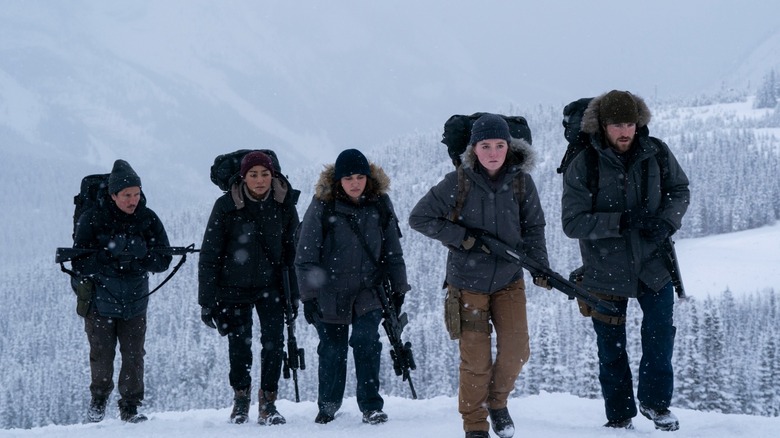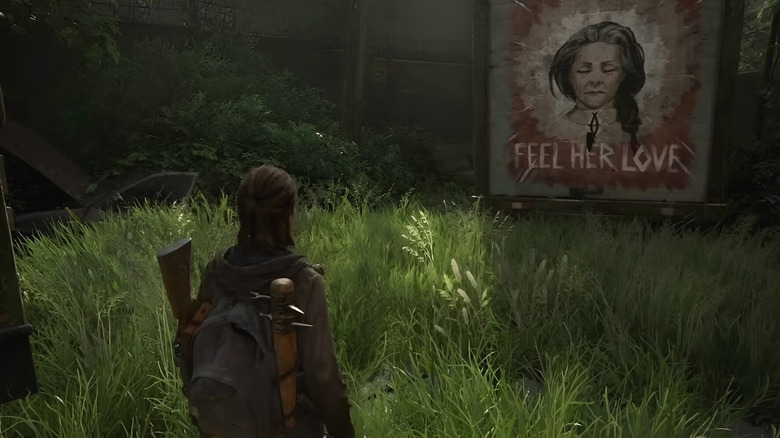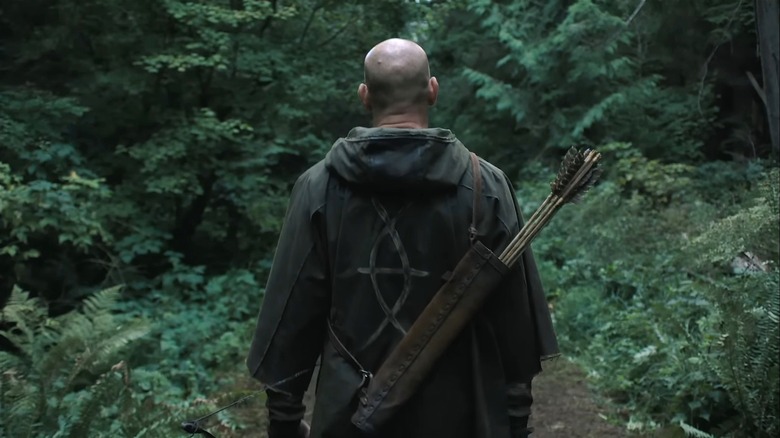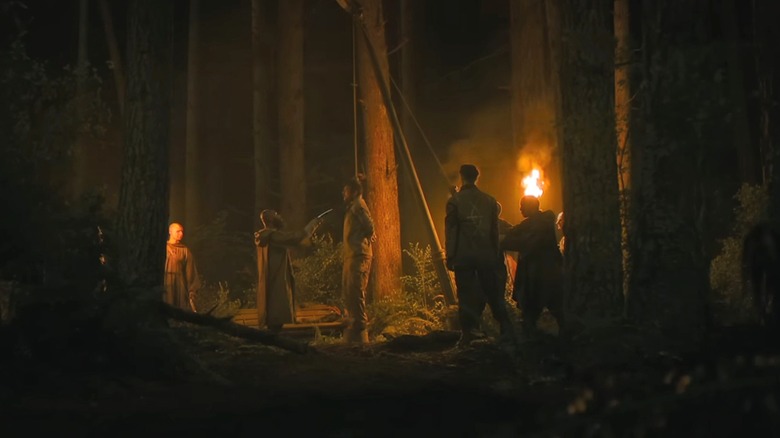The Seraphites: Everything You Need To Know About The Last Of Us Villains
This post contains spoilers for "The Last of Us" video game series and its HBO adaptation.
Season 2 of "The Last of Us" has already ventured past its point of no return with the heartbreaking gut-punch that is Joel's (Pedro Pascal) death. The latest episode maps the aftermath of the incident after a three-month jump, where both Ellie (Bella Ramsey) and Dina (Isabela Merced) are determined to avenge Joel, no matter the cost. While episode 3 acts as a necessary buffer between the intense trauma of losing Joel and the fresh hells that are about to be unleashed, we are also introduced to a new group trying to survive the apocalypse. At first glance, they seem like a religious community moving across Seattle to evade the infected, but their presence in the episode sets the foundation for one of the most antagonistic groups that inhabit the world of "The Last of Us": The Seraphites.
In Naughty Dog's "The Last of Us Part II," players can hear the Seraphites even before they're presented onscreen, thanks to a string of eerie whistling sounds that the group uses to communicate over distances. Also known as the Scars (every member sports a scar on each cheek), the Seraphites often use coded whistling to get the upper hand in fights where the odds are stacked against them. It becomes difficult to predict an enemy that disorients you from the get-go, making it easy for them to flank lone targets or promptly take down groups of two. The latest episode employs the group's coded whistling to warn them of incoming danger, but the wandering collective (which also included children) is brutally killed by another warring faction (who haven't been specified yet).
Although the episode frames the Seraphites and their mysterious ways as harmless, they'll soon strike back and make their vicious presence felt across the highly coveted state of Seattle. Let's learn more about this antagonistic faction from "The Last of Us Part II," gauge their motivations, and speculate on the role they might end up playing in the HBO adaptation.
The Seraphites started off as a relatively peaceful community after the outbreak
It's time to dive into some in-game lore and go back in time to a few years after the outbreak. Between 2013 and 2014, the Seraphites were formed under the leadership of a woman who (supposedly) had a spiritual vision that could help humans rebuild civilization on a grander scale. This woman, later dubbed the Prophet (more on her later), wrote hopeful sermons that promised the birth of a new world, while urging her followers to strive for peaceful co-existence with fellow humans.
You might already be aware of the escalating tensions between the Federal Disaster Response Agency (FEDRA) and the Washington Liberation Front (WLF) during the apocalypse, which often led to casualties on both sides. The Prophet, however, was content with etching out an isolated community of Seraphites on an island in Seattle; she was reluctant to be part of such violent clashes that would distract her people from their primitivist way of life. However, circumstantial clashes with both FEDRA and WLF eventually warped what the Prophet stood for, and the Seraphites soon realized that they needed to adopt a brutal, violence-first stance to survive in such an unpredictable world.
Although the group's roots were relatively peaceful, their core belief systems always hid a kernel of fanaticism, which only grew over time. What was once a community that sought to be independent and self-sufficient quickly evolved into a hateful, deeply violent group. Ellie's first encounter with the Seraphites in "Part II" is ample proof of their ideological deterioration, as they don't hesitate to pierce a young girl's skin with an arrow and aggressively chase her with torchlights at night.
The conflict between Seraphites and WLF/FEDRA in The Last of Us, explained
Next, we need to understand why the Seraphites clashed with both FEDRA and WLF in "The Last of Us" and how these three-way clashes shaped a chunk of events in the video game. FEDRA first encountered the Seraphites in 2014, finding the small community on the brink of starvation. Although FEDRA tried to persuade them to relocate inside the quarantine zones, they refused, managing to survive this crisis (an incident that the group perceived as a miracle later on).
As time passed, WLF and FEDRA clashed repeatedly as both groups wished to control Seattle for its relatively lucrative location as a fortified city. Once FEDRA's firm control over the city loosened, the Seraphites moved into former military settlements, causing pre-existing residents to be wary of their increasingly extreme belief systems. This prompted the residents to ally with the WLF, who steadily grew in numbers and persecuted several Seraphites, including a raid in Hillcrest (a location that Ellie visits in the game). The island-like space that most Seraphites lived on transformed rapidly despite these attacks, as the community mostly focused on growing their own crops and recuperating from losses.
After a brief spell of peace, reality invaded, and the Seraphites had to gear themselves for inevitable clashes with the WLF. To counter such a threat, they assembled able-bodied fighters, set up patrols, and caught WLF soldiers off guard with their unique communication tactics. However, their primitive tools (as opposed to the military-grade weapons used by the WLF) were not enough to protect their community, leading to droves of Seraphites dying due to this conflict. It is worth noting that the group viewed these painful struggles as a part of a greater plan that would eventually facilitate their collective salvation.
Who is the Prophet mentioned by the Seraphite in The Last of Us season 2?
When the Seraphites are introduced in the HBO series, an elderly man speaks to a female child in the group and explains a few things to her. We learn that the travelling group does not have a set destination in mind, but their primary directive is to keep the teachings of the Prophet alive, as she is eternal. This unnamed figure is the same one who founded the religious faction, and the older man's words denote that she is no longer alive, at least in the earthly realm. We know from the games that the WLF captured the Prophet at some point before "Part II," and their leader, Isaac Dixon, eventually ordered her execution. Several WLF accounts about the Prophet point to the fact that her teachings impacted their guards to a great degree, and that her views concerning an egalitarian society weren't as unsustainable as WLF propaganda painted them out to be.
"The Last of Us" season 2 has yet to delve into these complex circumstances, but we will likely be treated to a fleshed-out version of the conflicts that stretched over decades and culminated in the present. Although the Prophet is only ever mentioned in the game, season 2 might incorporate some flashbacks to offer a more tangible idea of her worldviews and how they shaped the Seraphites. As you can guess, her death was a turning point in Seraphite history, fueling their bloodthirsty approach to war and giving them a justification to hit back with lethal measures. This rage-fueled fighting spirit allowed them to take many WLF-controlled areas, and the attitude persisted over the decades.
As with most religious figures who establish a cult-like following, the Prophet was later treated as a martyr and a messiah, and her teachings began to be interpreted as tools to fight and win the war against enemies.
How the primitivist cult's beliefs impact their arc throughout The Last of Us Part II
Episode 3 allows us a glimpse into the Seraphites' way of existence, which paints them as a cult-like community who abide by the Prophet's sermons and stick to primitive weapons like hammers and arrows. As evidenced by what happens later, these weapons are no match for guns, and even the timeliest whistled warnings cannot save such a vulnerable group from a brutal ambush. Part II grants us plenty of insight into the group's collective mindset, including their belief that guns were part of the "old world," which, by extension, was considered sinful. As the group aims to attain salvation and step into the new world, they shun these weapons and favor anything that can be forged without a machine.
However, these beliefs aren't as steadfast as they seem, as the Seraphites often employed snipers (!) on higher floors to take out unsuspecting WLF patrollers, who believed that the group wouldn't reject their Prophet's sermons and use such "old world" weapons. From a neutral perspective, it is not hard to gauge why the Seraphites were willing to bend the rules, as circumstances demanded measures that would put them at an advantage, even though they were inferior both in terms of collective fighting tactics and numbers. With both factions eager for conflict, any attempts to broker peace didn't last very long, leading to noxious cycles of death and conflict.
Moreover, the increasing clashes with the WLF only intensified the group's devout fanaticism, as they wholeheartedly began to view their fight against the infected and the WLF as a divinely ordained test to attain salvation. In light of these extremist views that justified violent confrontations, the Prophet's sermons about the society-shattering Cordyceps outbreak being wrought as punishment for humanity's sins gained newfound significance. These evolving beliefs birthed new rituals, such as the scarification of those initiated to become soldiers, which was considered a rite of passage for every follower who devoted themselves to the Prophet's cause.
What we can expect from the Seraphites in future episodes of the HBO adaptation
Although there's a clear roadmap for the WLF-Seraphite conflict in the game, along with Ellie's run-in with them in 2038, the HBO series might take significant liberties to heighten the stakes. The structure of a combat and exploration-heavy game allows us to piece together lore and navigate maps at our own pace, but a television series needs to more clearly knit events together to generate interest. It is worth noting that the events of "The Last of Us Part II" paint the Seraphites as the most vicious, as they successfully wipe out droves of WLF soldiers while dismembering their bodies in horrific ways. These events eventually connect their fates with Abby (Kaitlyn Dever) and her friends, who are inevitably linked to Ellie and Dina's quest for revenge.
With this in mind, it is difficult to predict what directions the show might opt for, but episode 3 lays the groundwork for Ellie and Dina's involvement with the Seraphite problem. The duo deduce that the roadside ambush might've been orchestrated by Abby's group, which drives them further inside Seattle in search of clues that might grant them answers. Moreover, we know that Jeffrey Wright is portraying Isaac Dixon in the HBO series (Wright also provided the voice and motion-capture performance for the character in the game), which will undoubtedly set up storylines that will explore the nitty-gritties of WLF as a fringe group that suddenly rises to prominence in the city.
We can also expect violent clashes between the WLF and the Seraphites, where the latter manage to defeat military-trained soldiers through sheer grit (and the power of extremist ideologies) alone. Additionally, we might learn more about the Seraphites through prominent members featured in the game, such as Lev and Yara, giving us a more grounded understanding of how inter-faction conflicts doomed humanity instead of uniting them against a common enemy. But hey, these are just conjectures based on what happens in "Part II," and HBO's "The Last of Us" might switch things up for the better.
![[PLACEHOLDER HEADER UNTIL OFFICIAL STILLS FOR EP 3 ARE UPLOADED BY HBO]](https://www.slashfilm.com/img/gallery/the-seraphites-everything-you-need-to-know-about-the-last-of-us-villains/intro-1745508670.jpg)




